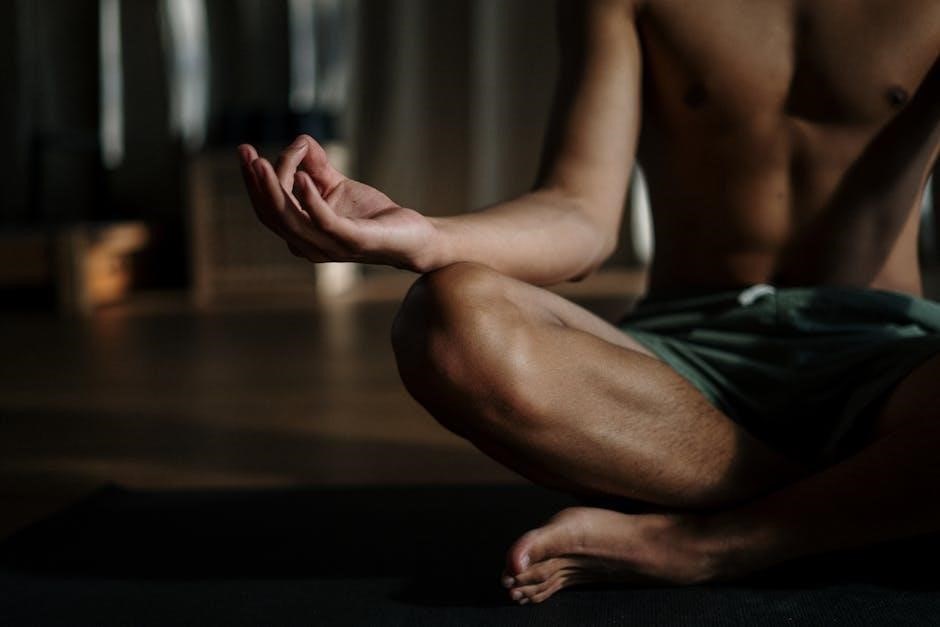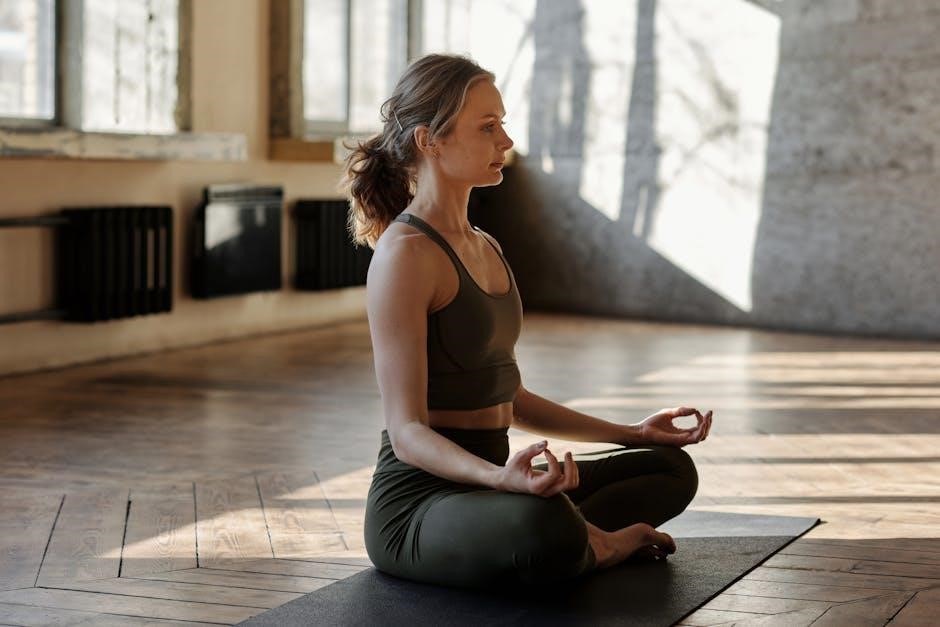Postural drainage is a technique involving specific positioning to use gravity to help clear secretions from the lungs. This method aids in mobilizing and removing mucus‚ improving respiratory function and preventing complications.

What is Postural Drainage?
Postural drainage is a chest physiotherapy technique utilizing gravity to assist in the removal of lung secretions. It involves positioning the patient to facilitate drainage from specific lung segments into the central airways.
Definition and Purpose
Postural drainage is defined as a therapeutic technique where the patient is positioned to use gravity to mobilize and drain secretions from specific lung segments into the larger airways. The primary purpose is to prevent the accumulation of secretions and effectively remove them from the lungs‚ thereby improving respiratory function;
This intervention is crucial for individuals with conditions that cause increased mucus production or difficulty in clearing secretions‚ such as cystic fibrosis or bronchiectasis. By strategically positioning the body‚ postural drainage helps to direct mucus towards the trachea‚ where it can be coughed out or suctioned.
The goal is to enhance airway clearance‚ reduce the risk of respiratory infections‚ and improve overall lung health. Postural drainage is often combined with other techniques like percussion and vibration to further loosen and mobilize secretions. It is a key component of comprehensive respiratory care.
How it Works: Gravity and Secretion Mobilization
Postural drainage leverages the power of gravity to mobilize and facilitate the removal of lung secretions; By positioning the patient so that the targeted lung segment is higher than the trachea‚ gravity assists in draining mucus from the smaller airways into the larger airways. This process makes it easier for the patient to cough up or have the secretions suctioned out.
The strategic use of different positions ensures that all lung segments can be effectively drained. The body is positioned at various angles‚ often with the head lower than the chest‚ to maximize the gravitational effect.
Secretion mobilization is enhanced through this positioning‚ allowing mucus to move more freely along the airways. This method is particularly beneficial for individuals with conditions like cystic fibrosis or bronchiectasis‚ where excessive mucus production hinders normal respiratory function. Postural drainage‚ therefore‚ promotes clearer airways and improved breathing.

Postural Drainage Positions
Specific body positions are crucial in postural drainage to effectively target different lung segments. These positions use gravity to assist in the mobilization and removal of secretions.
General Guidelines for Positions
When implementing postural drainage‚ several general guidelines should be followed to ensure effectiveness and patient safety. Each position should be maintained for a recommended duration‚ typically ranging from 3 to 15 minutes‚ allowing adequate time for gravity to assist in secretion mobilization.
Pursed-lip breathing exercises can be incorporated to help open airways and enhance mucus clearance. It is important to monitor the patient’s comfort and tolerance throughout the procedure‚ adjusting positions as needed to avoid discomfort or complications. Pillows or cushions should be used to provide support and maintain proper alignment during each position.
Ensure the patient is properly instructed on how to maintain the prescribed positions. Consideration should be given to any underlying health conditions‚ like congestive heart failure‚ potentially requiring modifications to the positions or eliminating head-down tilts. Always consult with a healthcare professional for personalized guidance.
Specific Positions for Lung Segments
Postural drainage utilizes various positions tailored to target specific lung segments‚ optimizing secretion removal from those areas. For the apical segments of the upper lobes‚ a sitting position leaning back is often employed‚ allowing gravity to assist drainage. To target the posterior segments of the upper lobes‚ the patient typically lies prone with pillows under the chest.
The superior segments of the lower lobes benefit from a prone position with the bed flat‚ while the anterior segments of the upper lobes require a supine position with pillows under the knees. For the lateral basal segments of the lower lobes‚ the patient lies on the unaffected side with a pillow under the hip.
The posterior basal segments of the lower lobes are drained with the patient in a prone position with the foot of the bed elevated. Each position aligns the targeted lung segment perpendicular to the ground‚ maximizing gravity’s effectiveness. Proper technique ensures optimal clearance.

Modified Postural Drainage
Modified postural drainage involves adaptations to traditional positions‚ often eliminating head-down tilts. These modifications cater to patients who cannot tolerate standard techniques‚ ensuring safer and more comfortable secretion mobilization.
Side-Lying Positions
Side-lying positions represent a modified approach to postural drainage‚ particularly beneficial for individuals unable to tolerate traditional head-down techniques. These positions facilitate secretion removal from specific lung segments while minimizing the risk of adverse effects such as gastro-oesophageal reflux or increased blood pressure. By positioning the patient on their side‚ gravity assists in draining mucus from the upper lung into the larger airways‚ promoting easier expectoration.
These positions are especially useful for patients with congestive heart failure‚ who may experience orthopnea when lying flat. Side-lying can also be effective in clearing excess secretions‚ offering a comfortable and well-tolerated alternative to head-down positions. Pillows can be used to achieve optimal angles for drainage. Furthermore‚ side-lying positions are often incorporated into comprehensive chest physiotherapy programs‚ alongside techniques like percussion and vibration‚ to enhance airway clearance and improve overall respiratory health.
Elimination of Head-Down Tilt
The elimination of head-down tilt in postural drainage represents a significant modification‚ particularly beneficial for patients who cannot tolerate the traditional Trendelenburg position. This adaptation aims to reduce the risk of complications such as increased intracranial pressure‚ gastroesophageal reflux‚ and cardiovascular strain‚ while still effectively mobilizing lung secretions. Research suggests that modified postural drainage positions‚ without the head-down tilt‚ can be as effective as traditional methods in clearing excess mucus from the lungs.
This approach often involves using side-lying positions or simply elevating the upper body with pillows to facilitate gravity-assisted drainage. Eliminating the head-down tilt makes postural drainage accessible to a wider range of patients‚ including the elderly‚ those with heart conditions‚ or individuals with abdominal distension. The focus shifts to optimizing lung segment alignment relative to gravity without compromising patient comfort or safety. This approach requires careful assessment and monitoring.
Techniques Used with Postural Drainage
Postural drainage is frequently combined with techniques like percussion‚ vibration‚ and shaking to loosen and mobilize secretions. Breathing exercises further enhance airway clearance and improve overall respiratory function during therapy.
Percussion‚ Vibration‚ and Shaking
Percussion‚ vibration‚ and shaking are manual techniques often employed alongside postural drainage to facilitate the loosening and mobilization of lung secretions. Percussion involves rhythmically striking the chest wall with cupped hands to create vibrations that dislodge mucus adhered to the airway walls. Vibration‚ typically applied during exhalation‚ uses a flat hand to create a shaking motion‚ further assisting in mucus detachment. Shaking is a more vigorous form of vibration‚ involving a tremulous movement applied to the chest wall during exhalation‚ promoting the upward movement of secretions.
These techniques are strategically applied over specific lung segments while the patient is in the appropriate postural drainage position to maximize their effectiveness. The combined effect of these techniques and postural drainage aids in the efficient clearance of secretions‚ improving ventilation and reducing the risk of respiratory complications. Careful application and consideration of the patient’s condition are essential for safe and effective use.
Breathing Exercises
Breathing exercises are a crucial adjunct to postural drainage‚ enhancing its effectiveness in clearing lung secretions. Techniques like diaphragmatic breathing‚ also known as belly breathing‚ promote deeper inhalation‚ improving ventilation to lower lung regions and aiding in mucus mobilization. Pursed-lip breathing helps to slow down the exhalation rate‚ preventing airway collapse and facilitating the expulsion of trapped air and secretions.
Controlled coughing techniques‚ such as the “huff” cough‚ are also incorporated to effectively clear loosened mucus from the airways without causing excessive strain or airway closure. These exercises are often performed in conjunction with postural drainage positions to maximize the impact of gravity and improve secretion clearance. Regular practice of these breathing exercises can improve lung capacity‚ strengthen respiratory muscles‚ and enhance overall respiratory health. Individualized instruction from a respiratory therapist is essential to ensure proper technique and optimal outcomes.

Considerations and Cautions
Postural drainage‚ while effective‚ requires careful consideration. Monitoring blood pressure is crucial‚ as positioning can impact it. Gastro-oesophageal reflux can be exacerbated‚ necessitating adjustments. Always consult a healthcare professional beforehand.
Monitoring Blood Pressure
During postural drainage‚ diligent monitoring of blood pressure is paramount‚ particularly in elderly patients. Positional changes inherent in this technique can induce fluctuations‚ potentially leading to hypotension or hypertension. Even in asymptomatic individuals‚ blood pressure alterations may occur‚ necessitating vigilant observation.
Pre-existing conditions‚ such as congestive heart failure‚ can further complicate matters‚ as patients may experience orthopnea (shortness of breath when lying flat). Regular blood pressure checks before‚ during‚ and after each postural drainage session are essential to ensure patient safety.
If significant changes are detected‚ adjustments to the positioning or cessation of the procedure may be required. Healthcare professionals should possess the expertise to interpret blood pressure readings and respond appropriately‚ mitigating potential adverse effects and optimizing patient outcomes. Careful monitoring ensures the safe and effective application of postural drainage.
Gastro-Oesophageal Reflux
Gastro-oesophageal reflux (GER) is a significant consideration during postural drainage‚ especially in individuals with conditions like cystic fibrosis‚ where GER prevalence is elevated. The positioning involved in postural drainage can potentially exacerbate reflux‚ leading to discomfort and complications.
The head-down tilt‚ traditionally used to enhance secretion mobilization‚ may increase the risk of gastric contents flowing back into the esophagus. Therefore‚ modified postural drainage positions‚ such as side-lying without a head-down tilt‚ should be considered‚ especially in patients prone to reflux.
Close monitoring for signs of reflux‚ such as heartburn or regurgitation‚ is crucial during and after the procedure. Healthcare providers should assess the patient’s history of GER and adjust the drainage technique accordingly. Strategies to minimize reflux‚ such as avoiding meals before treatment and elevating the head of the bed after‚ should be implemented. Careful attention to these factors ensures patient comfort and safety.
